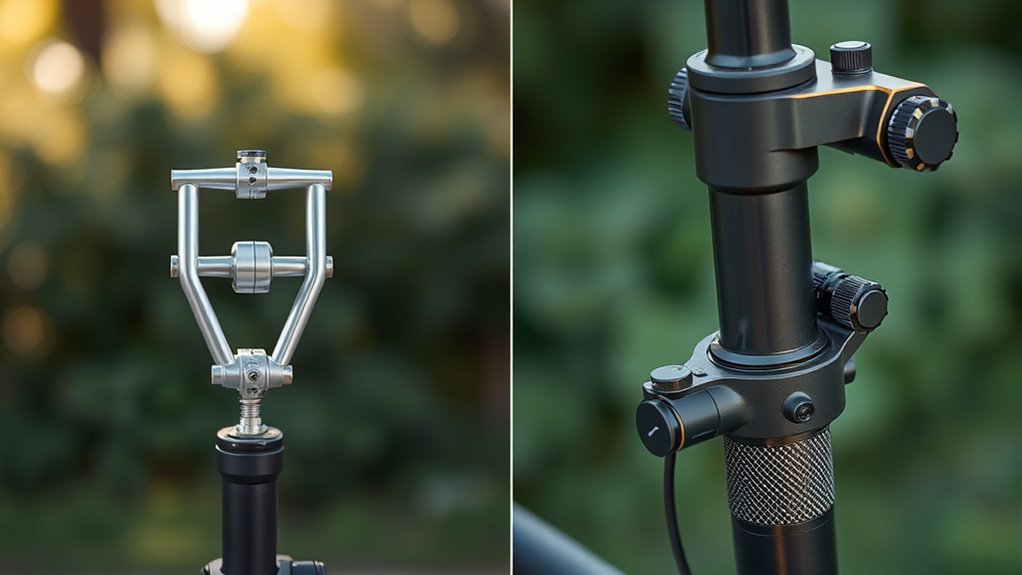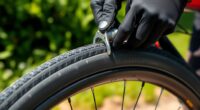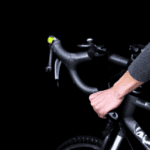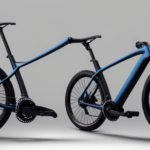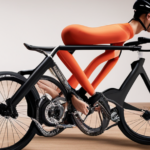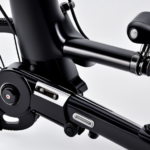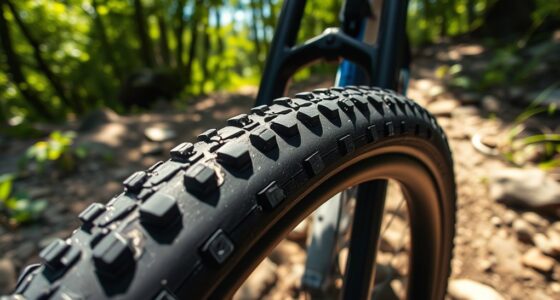Seatpost suspension options include parallelogram seatposts, dropper posts, and damper-equipped models. Parallelogram seatposts use linkage systems to absorb shocks while keeping the saddle stable and aligned. Dropper posts let you quickly adjust saddle height on the fly for better control on descents or climbs. Dampers improve comfort by absorbing vibrations and shocks, especially in hydraulic models. Understanding these options helps optimize your ride, and exploring further reveals how each system can enhance your performance.
Key Takeaways
- Parallelogram seatposts use linkage systems to absorb shocks while keeping the saddle stable and aligned during aggressive riding.
- Dropper posts allow quick saddle height adjustments on the fly, enhancing control on descents and technical terrain.
- Damper-equipped seatposts incorporate damping technology to absorb vibrations, improving comfort and handling over rough trails.
- Mechanical dropper posts operate via cables, offering simplicity and affordability, while hydraulic systems provide smoother, more precise control.
- Regular maintenance, including cleaning, lubrication, and damping adjustments, ensures optimal performance of suspension seatposts.
Understanding Parallelogram Seatposts and Their Mechanics
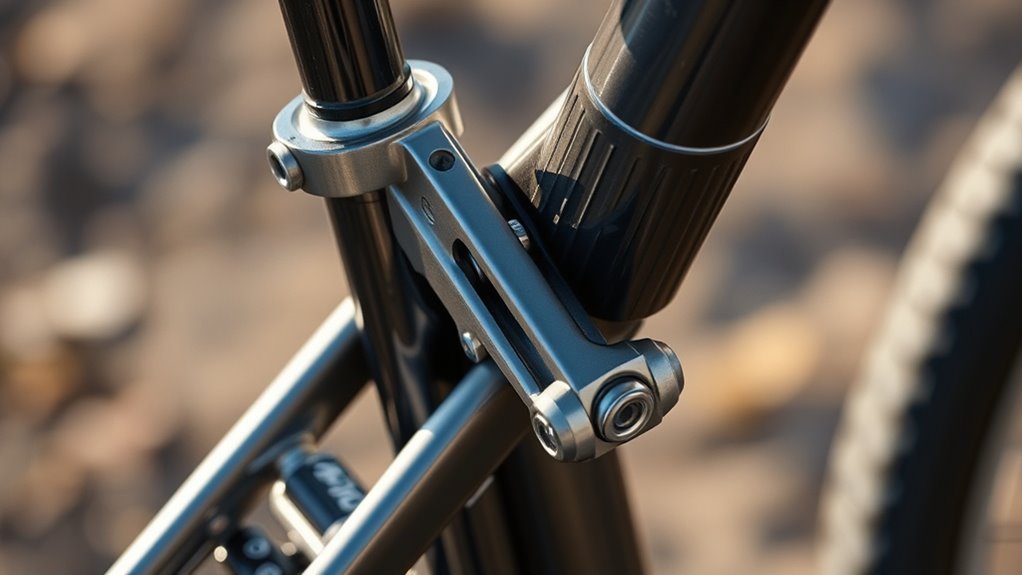
Parallelogram seatposts use a unique linkage system to provide smooth and consistent suspension. This innovative seatpost design allows you to maintain proper saddle position while absorbing shocks from rough terrain, making it ideal for mountain biking. The linkage system keeps the saddle aligned with your body, offering better control and comfort on technical trails. Unlike traditional seatposts, the parallelogram setup minimizes unwanted lateral movement, ensuring stability during aggressive riding. The design involves a series of pivots and arms that work together to allow vertical movement without compromising the saddle’s angle. As a result, you experience a more responsive ride, reducing fatigue and improving your overall handling. If you want reliable suspension without sacrificing control, understanding this seatpost design is essential.
The Functionality of Dropper Posts and How They Enhance Riding

Dropper posts are designed to give you quick and effortless saddle height adjustments on the fly, markedly improving your control and confidence during rides. In mountain biking, they allow you to lower your saddle instantly for technical descents, boosting stability and safety. When climbing or steering through tight corners, raising the saddle gives you better power transfer and mobility. For urban commuting, dropper posts help you quickly switch between riding postures—lowering for obstacle clearance or tight spaces, raising for comfort and efficiency. This adaptability keeps your ride smooth and responsive, reducing fatigue and enhancing your overall experience. With a simple press of a button or lever, you can fine-tune your saddle height without stopping, making your rides safer, more comfortable, and more enjoyable regardless of terrain or environment. Additionally, high-quality components in dropper posts ensure durability and reliable performance over time. Proper maintenance and understanding of adjustment mechanisms can further optimize your riding experience and extend the lifespan of your dropper post. Being aware of vetted options in the market can help you select the best product for your specific riding needs. Incorporating advanced design features can also lead to improved comfort and functionality during your rides.
How Damper-Equipped Seatposts Improve Comfort and Control

Damper-equipped seatposts absorb shocks and vibrations, giving you a smoother ride on rough terrain. They also help you stay in control by reducing unwanted movement, especially on technical trails. With these features, you’ll notice improved comfort and better handling on challenging surfaces.
Smoother Ride Experience
When you ride over rough terrain, a damper-equipped seatpost absorbs shocks that would otherwise jolt your spine and disrupt your focus. This smooths out your ride by reducing impact transfer, helping you stay comfortable and in control. The damper works with your bike frame and suspension linkage to adapt to varying trail conditions, providing consistent support. It minimizes vibrations and sudden jolts, so you can maintain better control without sacrificing efficiency. Additionally, understanding fandom’s past, present, and future can help industry professionals develop better products that cater to rider preferences and needs. Recognizing suspension technology trends is essential for improving seatpost performance and rider experience, especially as advancements in damper design continue to evolve.
Enhanced Terrain Control
Enhanced terrain control is made possible by damper-equipped seatposts, which actively adapt to changing trail conditions to improve your comfort and handling. These seatposts respond dynamically, absorbing shocks and reducing vibrations, giving you better control on rough terrain. The damper’s presence not only boosts ride quality but also influences seatpost aesthetics, allowing for sleeker designs that blend seamlessly with your bike’s look. Modern manufacturing materials, such as lightweight alloys and composites, ensure these seatposts remain durable and low-weight, even with added damping capabilities. Additionally, the integration of damping technology enhances ride responsiveness, helping you tackle technical sections confidently and comfortably. Understanding damping mechanisms further illustrates how these seatposts improve your riding experience. The use of advanced materials in manufacturing further contributes to durability and performance, ensuring longevity even under demanding riding conditions. Incorporating damping technology into seatpost design also reduces rider fatigue over long rides. This advanced control ultimately enhances your riding experience, whether you’re climbing steep trails or cruising over uneven surfaces.
Comparing Mechanical and Hydraulic Dropper Post Systems
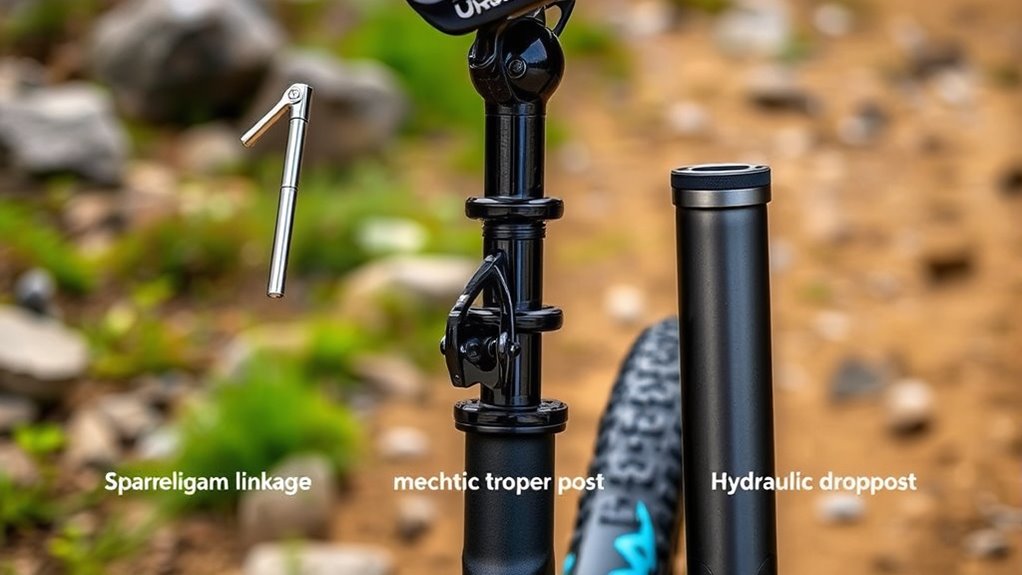
Choosing between mechanical and hydraulic dropper post systems depends on your riding style and maintenance preferences. Mechanical systems are straightforward, often using cable-actuated mechanisms compatible with various seatpost materials. They are easier to install with basic tools, making installation techniques simpler. Hydraulic dropper posts, on the other hand, rely on fluid pressure for smoother operation and often provide more precise control. They typically require more complex installation techniques, including bleeding the system to remove air bubbles. Mechanical posts tend to be lighter and more affordable, ideal for riders seeking low-maintenance options. Hydraulic posts offer superior actuation and reliability on rough terrain but may need regular maintenance. Your choice hinges on how much maintenance you’re willing to perform and whether you prioritize ease of installation or performance. Vibrational energy can also influence the responsiveness of your suspension system, highlighting the importance of choosing the right type for your riding conditions. Additionally, advancements in AI security technologies are continually improving the safety and reliability of these systems, making informed choices even more critical.
Benefits of Using a Parallelogram Seatpost on Technical Trails

A parallelogram seatpost keeps your pedaling efficient even on rough terrain, so you can power through technical sections without losing momentum. It also gives you better control over your bike, making tricky maneuvers more manageable. Plus, by absorbing shocks, it helps reduce fatigue, so you stay fresh longer on demanding trails. Additionally, the rustic aesthetic of a parallelogram seatpost complements the overall design and feel of a bike built for adventurous terrain.
Maintains Pedal Efficiency
When riding technical trails, maintaining pedal efficiency is essential for conserving energy and maximizing control. A parallelogram seatpost helps achieve this by reducing pedal bob, so your energy isn’t wasted moving the saddle unnecessarily. Its design minimizes movement, even on rough terrain, keeping your pedaling smooth and effective. Although the seatpost weight might be slightly higher, the benefits outweigh the extra grams, especially for technical riding. Installation complexity is manageable with proper tools, and once set up, it offers reliable performance. This seatpost ensures you stay efficient, power transfer remains consistent, and you can focus on maneuvering tricky sections without losing momentum. Additionally, understanding ethical hacking principles can help in securing your bike’s electronic components from cyber threats. Incorporating knowledge of Gold IRA Rollovers can also inform long-term investment strategies outside of cycling, ensuring financial stability for enthusiasts planning for the future. Furthermore, selecting the right gadget accessories can enhance your riding experience by adding convenience and functionality.
Enhances Bike Control
Because it minimizes saddle movement, a parallelogram seatpost considerably enhances your control on technical trails. By keeping your saddle stable, you can focus on steering and balancing without unnecessary distractions. The design offers precise saddle positioning, helping you respond quickly to obstacles and tricky terrain. While a lightweight seatpost is ideal for maintaining agility, the added suspension costs are often justified by improved handling. The increased stability allows you to navigate technical sections with confidence, reducing the chance of losing control. Although the seatpost adds some weight, the benefit of enhanced bike control outweighs this for serious trail riders. Overall, a parallelogram seatpost helps you stay composed and confident, even on challenging, technical trails.
Reduces Rider Fatigue
Using a parallelogram seatpost can considerably reduce rider fatigue on technical trails by absorbing shocks and vibrations that would otherwise transfer directly to your body. This suspension system minimizes the physical toll of rough terrain, helping you maintain focus and endurance longer. It also helps preserve your energy, especially during long rides or steep climbs. Keep in mind that while a parallelogram seatpost enhances comfort, it may add weight considerations, impacting aerodynamic efficiency. To maximize benefits, consider these points:
- Absorbs shocks and vibrations effectively
- Reduces muscle strain and fatigue
- Maintains better control on technical sections
- Slightly increases overall bike weight
- Can improve riding efficiency over uneven terrain
- Sound design techniques can be used to further optimize the rider’s experience by tailoring the auditory feedback of the suspension system. Additionally, selecting the right seatpost suspension can enhance the effectiveness of shock absorption and overall ride quality. Incorporating advanced materials in the design can also help balance weight and durability for better performance. Furthermore, integrating innovative engineering can lead to improved responsiveness and durability of the suspension system.
The Advantages of Adjustable Dropper Posts for Different Terrain
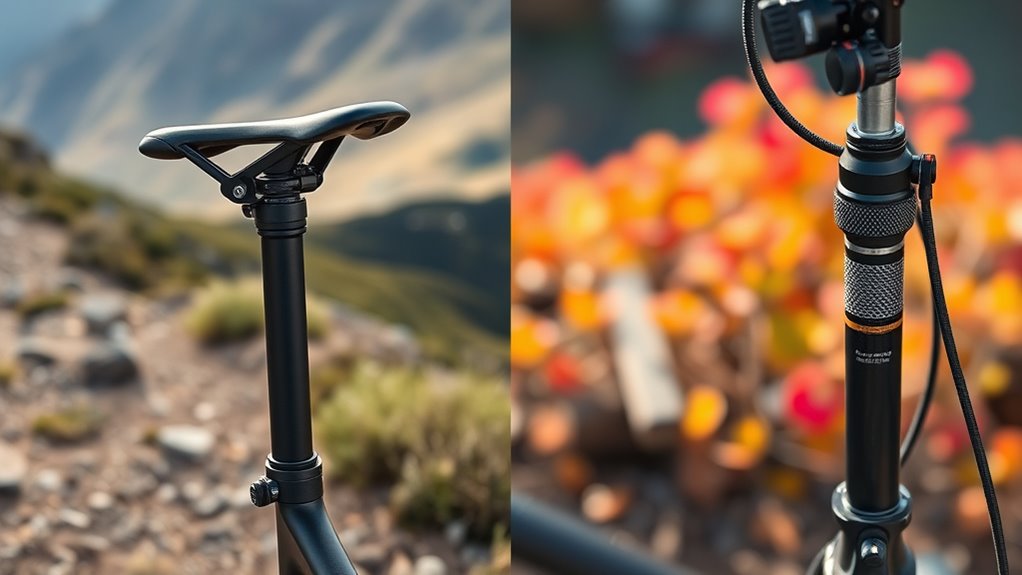
Adjustable dropper posts provide a significant advantage across varying terrain by allowing you to quickly modify your saddle height on the fly. Whether you’re mountain biking on technical descents or steering through urban commuting routes, this flexibility enhances control and comfort. On rugged trails, lowering your saddle lets you shift your weight backward for better stability and maneuverability. Conversely, raising it improves pedaling efficiency on climbs. For city rides, an adjustable dropper helps you quickly adapt to uneven surfaces or obstacles, keeping you more confident and relaxed. With a simple lever, you can make these adjustments without stopping, saving time and effort. Overall, these posts give you the versatility to handle diverse environments, making every ride safer, more comfortable, and more enjoyable.
The Role of Damping in Seatpost Performance and Ride Quality
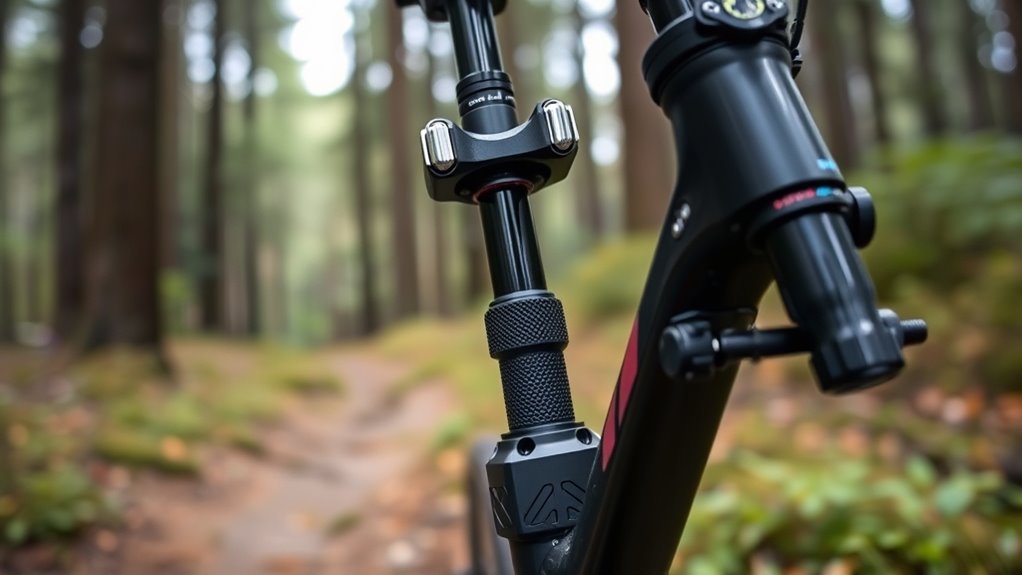
Damping plays a crucial role in how a seatpost absorbs shocks and vibrations, directly impacting your ride quality. It controls how quickly the suspension recovers after compression, ensuring a smooth, controlled ride. With an air spring, damping manages the force and speed of rebound damping, preventing excessive bouncing. Proper damping settings improve comfort and stability, especially on rough terrain. Here are some key points:
Damping controls rebound speed, enhancing ride comfort and stability on rough terrain.
- Air spring provides consistent support and easy pressure adjustments
- Rebound damping controls how fast the seatpost returns to position
- Proper damping prevents harsh impacts and excessive oscillation
- Correct damping enhances control during technical descents
- Fine-tuning damping settings boosts overall comfort and ride confidence
Effective damping ensures your suspension functions efficiently, delivering a balanced, comfortable ride every time. Understanding the importance of damping in suspension systems can help you optimize your bike’s performance and adjustments for different terrains. Additionally, damping adjustments allow for tailored ride experiences to match various riding styles and conditions.
Factors to Consider When Choosing a Seatpost Suspension System
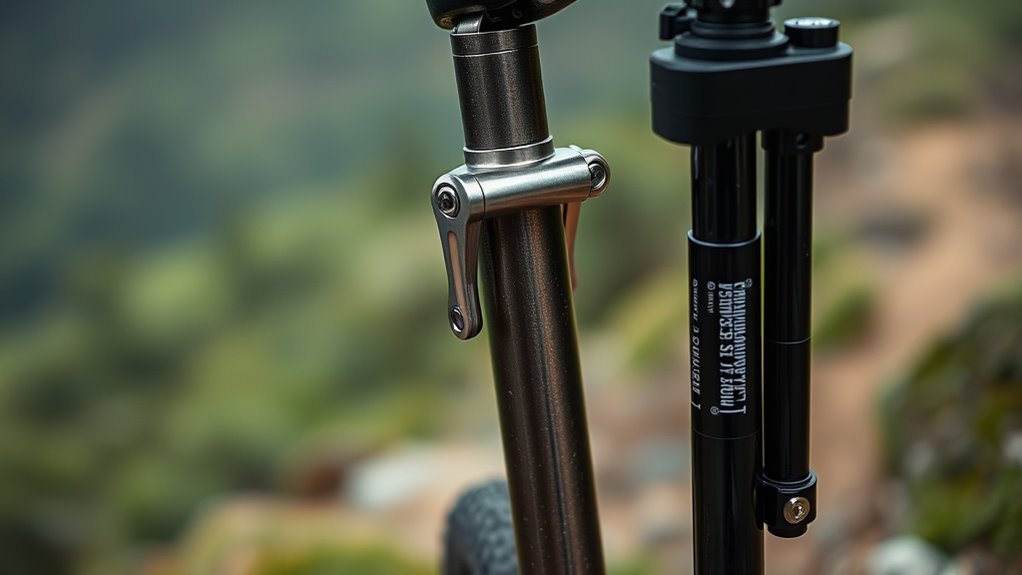
Choosing the right seatpost suspension system involves evaluating several vital factors to guarantee it meets your riding needs. In mountain biking, comfort and control are key, so consider how well the suspension absorbs shocks without sacrificing efficiency. Durability is also essential; a sturdy seatpost can withstand rough terrain and frequent use. Think about weight, as lighter systems improve handling, especially on climbs. Adjustability matters too—look for options that let you fine-tune compression and rebound to match your riding style. Compatibility with your bike frame is fundamental to avoid installation issues. Lastly, consider your budget, since higher-end systems often deliver better performance and durability. Balancing these factors helps you select a suspension that enhances your ride, boosts confidence, and withstands the demands of mountain biking.
Maintenance Tips for Ensuring Optimal Performance of Your Seatpost Suspension

To keep your seatpost suspension performing at its best, regular maintenance is key. Proper upkeep guarantees smooth operation and preserves your bike fit and saddle height. Start by cleaning the suspension thoroughly after dirt rides to prevent debris buildup. Regularly check for leaks or damage, and lubricate moving parts as recommended by the manufacturer. Keep an eye on air pressure or damping settings, adjusting as needed for your riding style. Also, inspect the bolts and fasteners to make sure everything stays tight.
Here are some essential maintenance tips:
- Clean your suspension after every ride
- Check for leaks or damage
- Lubricate moving components
- Verify saddle height and bike fit
- Adjust damping settings periodically
Conclusion
Choosing the right seatpost suspension is like finding the perfect rhythm in your ride. Whether you opt for a graceful parallelogram, a versatile dropper, or a damped marvel, each option helps you glide smoothly over life’s bumps. By understanding these systems, you’ll enhance your comfort and control, turning every trail into a flowing dance. Trust your instincts, keep everything well-maintained, and let your bike’s personality shine through each adventurous twist and turn.
